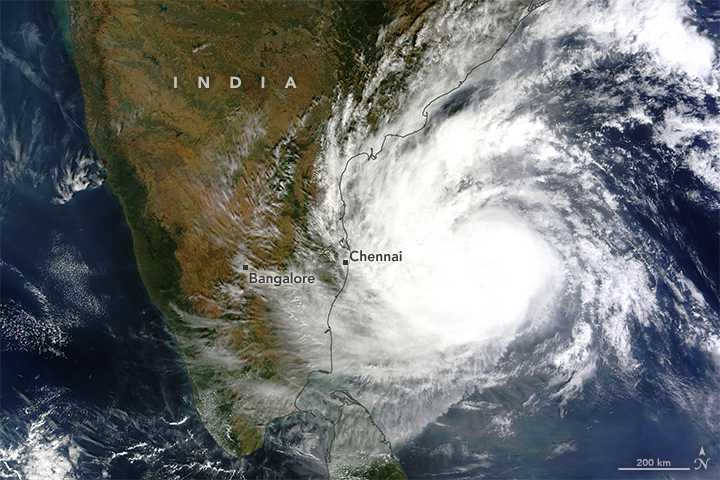A year ago, after visiting India in December 2015, I wrote about the record-setting rains and floods in the city of Chennai, where my parents and sister live. Almost 14 inches of rain fell within a matter of 24 hours, and that was merely one of the rain spells. With all the reservoirs full, authorities had to open up the gates, which then flooded the city.
A year later, the same city but another extreme event. A “super cyclone” changed course and aimed straight towards the city. It is an irony that the cyclone was named Vardah, which means red rose. A beauty of a red rose it was not. In a couple of hours, the winds had toppled about a quarter of the trees in the city. Transformers blew up, utility poles cracked and fell, and power and communication systems were knocked out. Some of the more than eight million people in the area were without power and water for more than a week.
Because of the cyclone, the airport was closed. I was already en route, and was held back in Dubai for a day. The night that I landed in Chennai, the city was pitch dark at most places—no electricity. Fallen tree branches—and entire trees too—made the drive home from the airport eerie. Like practically everybody else in the city, my parents were also sitting by the candle light and waving a plastic fan about themselves in order to keep themselves cool and to shoo away the mosquitoes that couldn’t care about the cyclone.
The following morning, I walked about the city. This was as close as I have been to a landscape that can be described as a war zone. Entire trees uprooted. Buildings with facades blown off. Walls destroyed. And a strange silence in contrast to the high noise levels that otherwise typically assault my senses.
 |
| Source |
The rain and floods of December 2015, and the super-cyclone of December 2016, will now be followed by drought. Yes, water shortage. The state of Tamil Nadu, for which Chennai is the capital, is reeling from a monsoon that failed—the second worst in over 150 years. “The latest spell of rain due to Cyclone Vardah has only brought down the State’s deficit from 66 per cent to 61 per cent, says S. Balachandran, Director in the Meteorological Department.” If not for the moisture that the cyclone brought with it, the city and the state would be in an even worse situation.
Such extremes are consistent with climate weirding. I way prefer the phrase “global weirding” because it helps avoid unnecessary debates with deniers who want to contest global warming. The same deniers also typically point to changes in weather in order to raise pointless questions about global climate changes. Finally, global weirding helps me understand the kinds of extreme weather stories that have become all too common.
Extreme events are beyond the predictability that humans have lived by. The monsoons, for example, have wild swings these days. When it rains, it seems to pour all at once. Or, it rains when it should not. And, like this past season, the rains are deficient. This is especially a disaster for developing countries like India where a significant percentage of the population relies on intensive agriculture. The drought in Tamil Nadu has already resulted in a few farmers worried about their misfortunes committing suicide.
Climate scientists warn that we have to prepare for more and more extreme events that result from climate weirding. The Intergovernmental Panel on Climate Change (IPCC) noted that “a changing climate leads to changes in the frequency, intensity, spatial extent, duration and timing of extreme weather and climate events, and can result in unprecedented extreme weather and climate events.”
Of course, it is not merely about the rains. Heat waves, for instance, are increasing in both frequency and intensity. Unlike wind and rains, heat waves are not action made for cameras. Thus, unlike with a cyclone, for instance, there are no images and videos that go viral when it comes to heat waves. But, heat waves kill more people than rains and cold spells do. It is then not difficult to understand that heat waves during water-deficit situations can become disasters in tropical areas like India.
We in the United States need to stop denying the human cause in the global climatic changes in this industrial era. As a country with an affluence that is the envy of the rest of the world, we need to assume leadership in addressing global weirding. These will be enormous challenges during the demagogue's presidency and with the Grand Old Minions controlling Congress. But, we have overcome challenges in the past; here, too, I hope that we will eventually do the right thing.
2 comments:
Chennai has had two consecutive season of disasters. Mention should be made of how prepared the government was, how few casualties there were and how, given the scale of destruction, restoration was relatively quick.
The cycle of droughts and floods is common in India as you know. I am not so sure that the cycle has changed drastically. The linkage between global warming and extreme weather is not so overwhelming as the general adverse effects of warming per se. We had copious rain last year in Tamil Nadu. We have been casual in creating water systems to store the excess and manage the deficits. That is within our control. The lamentable carelessness in water management deserves as much criticism as the lack of action on warming.
Of course, the disaster preparedness and the clean-up efforts are strikingly awesome compared to the dysfunctional political system. But, the commentary was not about those issues.
Yes, there is a cycle of droughts and floods. But, to quote from the IPCC, climate change increases the probability of not only more droughts and floods but also their intensity.
Post a Comment